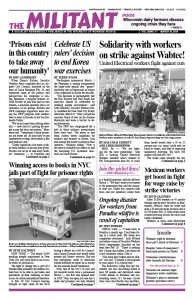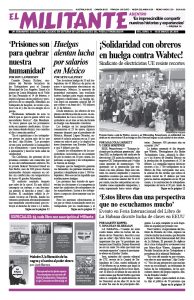HAVANA — A tornado ripped through five city districts here Jan. 27, wrecking hundreds of homes and buildings. Today new apartments are being turned over to residents who lost their homes, and repairs are underway for hundreds of others.
A week after the storm, Militant reporters who were in Cuba joined Cuban volunteers in the Luyanó neighborhood in the Diez de Octubre district for a day of reconstruction labor. (See Militant article in Feb. 18 issue.) We went back Feb. 23 to talk with workers we met during our first visit about how things were going.
We walked up and down the block looking for the house of Barbara Borrego, a retired hospital worker whose home was destroyed by the tornado. She had showed us the destruction during our first visit.
Now in place of the three unsteady walls of wood barely standing with no roof, a brigade of construction workers has already built her a new house out of concrete blocks and were finishing up the plumbing and flooring. Along her street other brigades were working intensely on other damaged homes.
The tornado damaged some 3,500 homes, along with hospitals, clinics, schools and other facilities. Cuba’s mass organizations, supported by the government, guided the work of hundreds of residents and other volunteers who went into action immediately. They cleared the debris, preparing the way for specialized brigades that restored electricity, telephone lines and the water supply and then began reconstruction.
We asked Borrego how the construction was being paid for. “No one has said anything to me about that,” she said. “They just came and began building.”
Ongoing reconstruction
“It’s a beehive!” Carlos Antonio de Dios Oquendo, general secretary of the National Construction Workers Union (SNTC), told Trabajadores, referring to the construction workers and residents involved in reconstruction. Crews start very early and work until late into the night.
In addition to the work of the construction brigades, residents are doing their own repairs using materials purchased at steeply discounted prices through low-interest government loans and grants. To respond to the dire need for housing — both as a result of the tornado and of a chronic shortage in Havana — government departments have been asked to turn over unused or little-used facilities to be rebuilt into housing.
“We have a big housing problem,” said Alexander Ochoa, 40, a physical therapist at the Luyanó Policlinic. The clinic suffered major damage from the tornado and is being rebuilt virtually from the ground up. Ochoa was helping load removed roofing panels onto a truck. The panels were headed for use at a housing project in Arroyo Naranjo, another Havana district, one that wasn’t hit by the tornado.
Many of the residents we spoke to were aware of the social disaster faced by working people in Puerto Rico after Hurricane Maria devastated the island a year and a half ago. In contrast to the reaction of Cuba’s revolutionary government to the tornado, Washington and the colonial government in Puerto Rico left working people there without electricity and water for months and thousands are unable to rebuild their homes.
They were shocked to hear about the scores of people — ill, elderly, and disabled, as well as the homeless — who have died in the U.S. from the cold this winter because of government neglect. This is simply the way the capitalist system functions, we explained. If something doesn’t generate a profit for the capitalist rulers, those in power just turn their backs. Such immorality is extremely difficult for workers and farmers raised in revolutionary Cuba to grasp.

